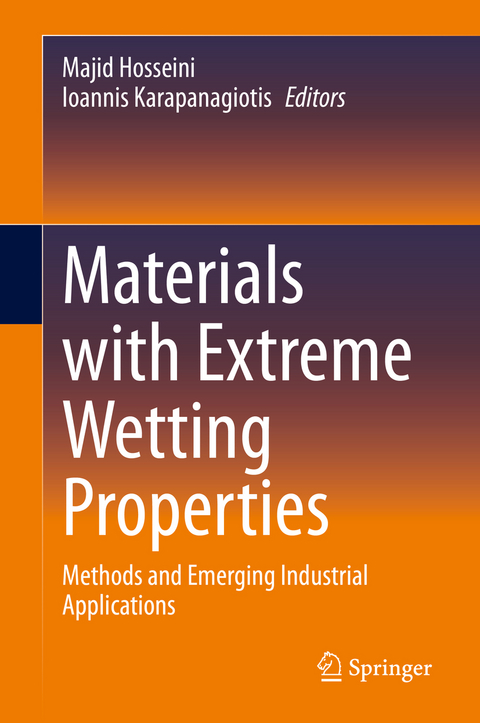
Materials with Extreme Wetting Properties
Springer International Publishing (Verlag)
978-3-030-59564-7 (ISBN)
This book aims at identifying novel advanced materials of extreme wetting properties (MEWP) for practical, industrial applications. The state-of-the art superhdyrophobic, superhdyrophilic, superoleophobic, superoleophilic, and superomniphobic materials, that are MEWP, with respect to their technological and emerging industrial applications are discussed in this book. MEWP offer new perspectives providing numerous potential applications. Hence, these advanced MEWP have the potential to lead to a new generation of products and devices with unique properties and functionalities. Despite the large scientific progress on MEWP there are still some obstacles which have to be solved to make these materials available for real life applications. Recent advances on the production strategies, including methods and materials, of MEWP has shown that the durability and sustainability obstacles can be addressed thus offering the possibility for industrial exploitation. MEWP with wettabilities ranging from superhydrophobicity to superhydrophilicity provide promising avenues for several and important applications, which sometimes are crucial for the humankind. This book also discusses a large variety of other potential applications of MEWP, thus providing new ideas to scientists and engineers for further exploitation of these novel materials. Moreover, the whole spectrum of the recent technological developments, current research progress, future outlook, and the modern trends in the applications of MEWP are discussed in a consistent approach.
lt;p>Dr. Majid Hosseini has earned both his Ph.D. and M.S. degrees in Chemical Engineering from The University of Akron in Ohio, United States, while also holding a professional certificate in Innovation and Technology from Massachusetts Institute of Technology in Massachusetts, United States. He has also completed an MSE degree in Manufacturing Engineering at UTRGV in Texas, United States and a Bachelor's degree in Chemical Engineering at Sharif University of Technology in Tehran, Iran. Dr. Hosseini is the editor of multiple high caliber books, has published several peer reviewed research articles and book chapters, and has co-invented patents application technologies. He has served as a key speaker at multiple international conferences and has been actively engaged in technology development. Dr. Hosseini's research interests, expertise, and experiences are diverse, ranging from smart bio-/nanomaterials, smart polymers and coatings, nanoparticles, and bio-/nanotechnology to bioprocess engineering and development, biomanufacturing, biofuels and bioenergy, and sustainability.
Dr. Ioannis Karapanagiotis has obtained his Ph.D. in Materials Science and Engineering from the University of Minnesota, USA, and his diploma in Chemical Engineering from the Aristotle University of Thessaloniki, Greece. He serves as a member in editorial boards and reviewer in several journals (more than 100), and he has published multiple research papers (more than 150) in peer-reviewed journals, books, and conference proceedings. Dr. Karapanagiotis specializes in interfacial engineering and its applications on the protection and conservation of cultural heritage and in the physicochemical characterization and analysis of cultural heritage materials which are found in historic monuments, paintings, icons, textiles, and manuscripts. Dr. Karapanagiotis is an associate professor at the Department of Management and Conservation of Ecclesiastical Cultural Heritage Objects, University Ecclesiastical Academy of Thessaloniki, Greece.
Robust, superhydrophobic self-cleaning surfaces.- Structural color films with lotus effects.- Transparent superhydrophobic surfaces.- Self-Recovery Superhydrophobic Surfaces.- Non-fluorinated superhydrophobic films.- Superhydrophobic Sponges.- Electrochemical Processes for the production of Superhydrophobic Surfaces.- Superhydrophobic polymer/nanoparticle composites.- Superhydrophobic polyimide films.- Superhydrophobic polymer/carbon composites.- Superhydrophobic cellulose surfaces & fabrics.- Superhydrophobic Coatings for Flexible and Wearable Sensing Electronics.- Superhydrophobic wood surfaces.- Functional and smart coatings for corrosion protection.- Superhydrophobic surfaces from austenitic stainless steel.- Corrosion resistant superhydrophobic aluminium and copper alloys.- Stimuli-Responsive Surfaces for Reversible Control of Wettability.- Graphene: From Superhydrophilic to Superhydrophobic Surfaces.- Porous graphene for efficient water and wastewater treatment.- Robust superamphiphobic coatings.- Emerging applications of superhydrophilic-superhydrophobic micropatterns.- Transparent superomphiphobic coatings.- Superomniphobic membranes to capture CO2.- Engineered wettability for dew collection.- Robust superhydrophobic surfaces for effective oil-water separation.- Superhydrophobic breathable fibrous membranes.- Smart fluid gating membranes.- Bio-inspired anti-icing coatings.- Antibacterial and superhydrophobic surface coatings.- Superhydrophobic blood-repellent surfaces.
| Erscheinungsdatum | 01.03.2021 |
|---|---|
| Zusatzinfo | XVI, 370 p. 167 illus., 143 illus. in color. |
| Verlagsort | Cham |
| Sprache | englisch |
| Maße | 155 x 235 mm |
| Gewicht | 746 g |
| Themenwelt | Naturwissenschaften ► Chemie ► Physikalische Chemie |
| Technik ► Maschinenbau | |
| Schlagworte | Anti-bacteria • Anti-corrosion • Anti-icing • Dewetting • Superhdyrophilic • Superhdyrophobic • Superoleophilic • Superoleophobic • superomniphobic • wettability • Wetting |
| ISBN-10 | 3-030-59564-1 / 3030595641 |
| ISBN-13 | 978-3-030-59564-7 / 9783030595647 |
| Zustand | Neuware |
| Haben Sie eine Frage zum Produkt? |
aus dem Bereich


